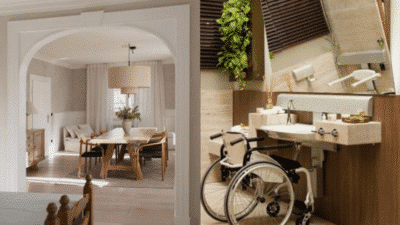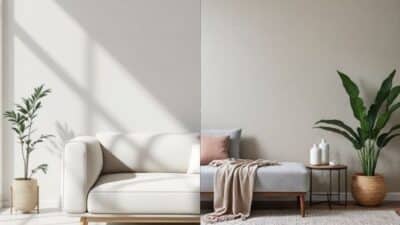Creating a space where your child can thrive, dream, and just be themselves is one of the most rewarding parts of setting up a home. A kid’s bedroom isn’t just a place to sleep; it’s their personal universe, a launchpad for imagination, a sanctuary for quiet moments, and often, the epicenter of epic playtime. It’s where they’ll build forts, read countless stories, play with friends, and maybe even attempt to do homework. Designing this special room can feel like a big project, but it doesn’t have to be stressful. In fact, it should be just as fun and playful as your child! We’re here to help you ditch the sterile, showroom look and embrace a truly fun, casual, and functional haven that grows with your little one. Let’s dive into some awesome ideas to make their room the coolest spot in the house.
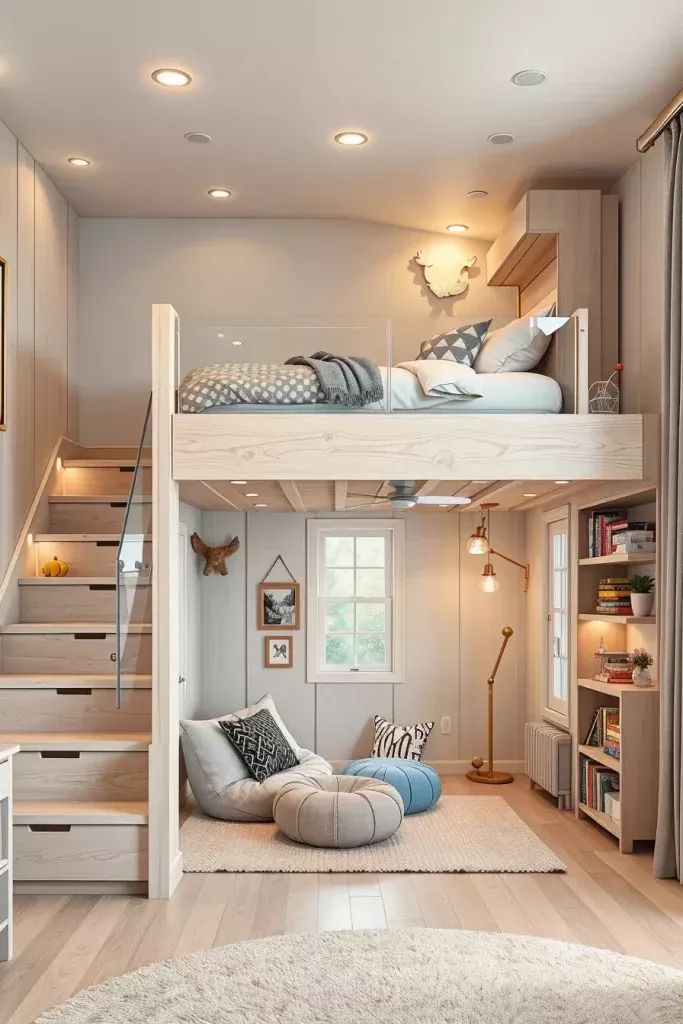
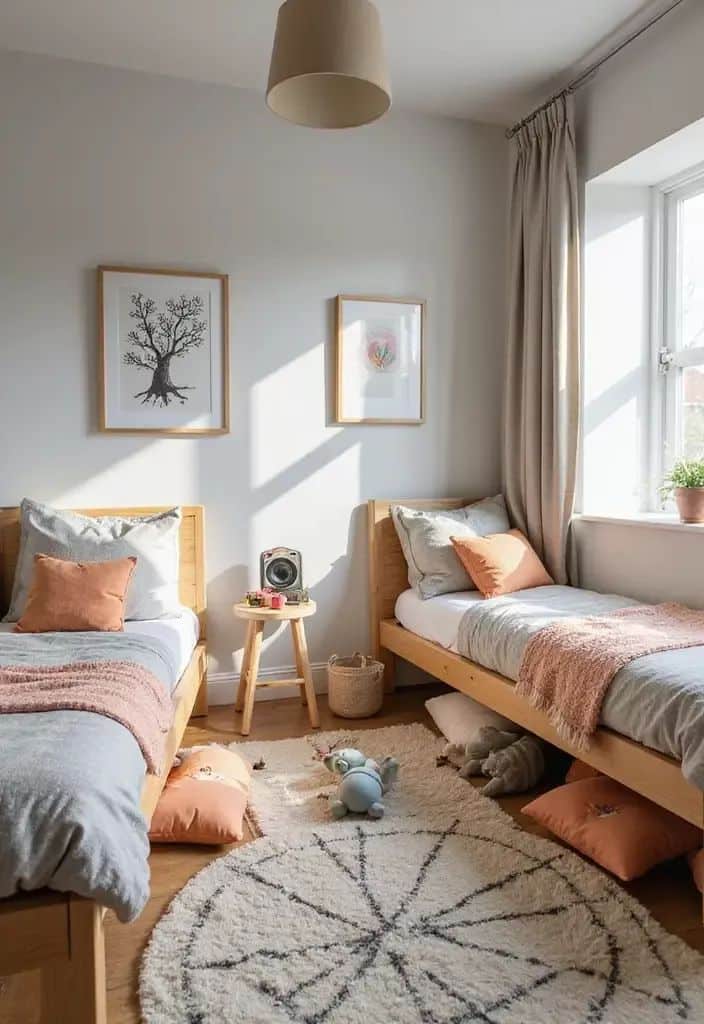
Understanding Your Child’s World: Age-Appropriate Design
Before you even pick out a paint swatch, take a moment to consider who you’re designing for. A toddler’s needs are vastly different from those of a pre-teen. Tailoring the design to their current age and anticipating their future growth will save you headaches (and redecorating costs) down the line.
The Toddler & Preschooler Zone (Ages 1-5)
For the littlest ones, safety is paramount. Think soft surfaces, rounded edges, and secure furniture. But beyond safety, this is a time for explosive development. Design their room to encourage exploration and play.
- Low-Level Accessibility: Keep toys, books, and art supplies within easy reach on low shelves or bins. This fosters independence.
- Sensory Engagement: Introduce different textures, bright colors, and engaging visuals. A soft rug, a bumpy sensory wall panel, or even a simple mobile can stimulate their senses.
- Play Space: Dedicate a significant portion of the room to open play. A small tent, a soft mat, or a mini slide can turn their room into an adventure park.
The Young Explorer’s Retreat (Ages 6-9)
As children grow, their interests blossom. They’re more independent, have definite opinions, and usually a growing collection of “treasures.” This age group often loves themes and opportunities for creative expression.
- Themed Decor: This is the prime age for dinosaur rooms, princess castles, space explorations, or jungle adventures. Involve them in choosing a theme that genuinely excites them.
- Craft & Creation Station: A small desk and chair with art supplies encourage drawing, coloring, and imaginative projects. Make sure it’s durable and easy to clean.
- Display Areas: Provide shelves or pinboards for them to showcase their artwork, trophies, or cherished toy collections. This validates their interests and gives them ownership of their space.
The Pre-Teen Hangout (Ages 10-12)
Pre-teens are on the cusp of adolescence. They crave privacy, personal style, and a space where they can hang out with friends or retreat into their own world. The “casual” aspect really shines here.
- Personalization is Key: Let them express themselves! Offer choices for bedding, wall art, and accent colors. They might want posters of their favorite bands or sports teams.
- Study Nook: Homework becomes a real thing. A comfortable desk, good lighting, and organized storage for school supplies are essential.
- Chill-Out Zone: A comfy beanbag, a small sofa, or floor cushions create a relaxed spot for reading, listening to music, or hanging out with pals.
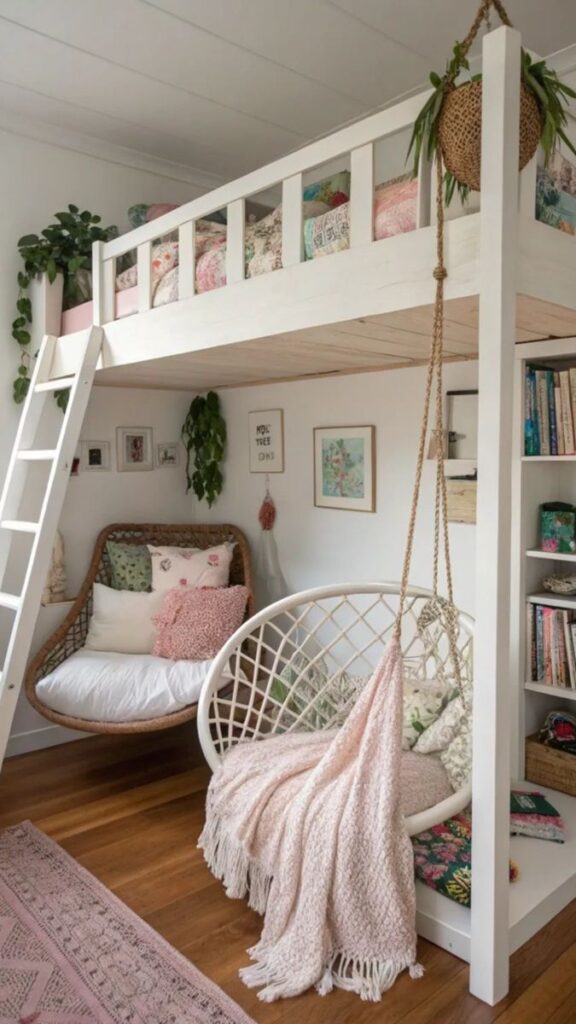
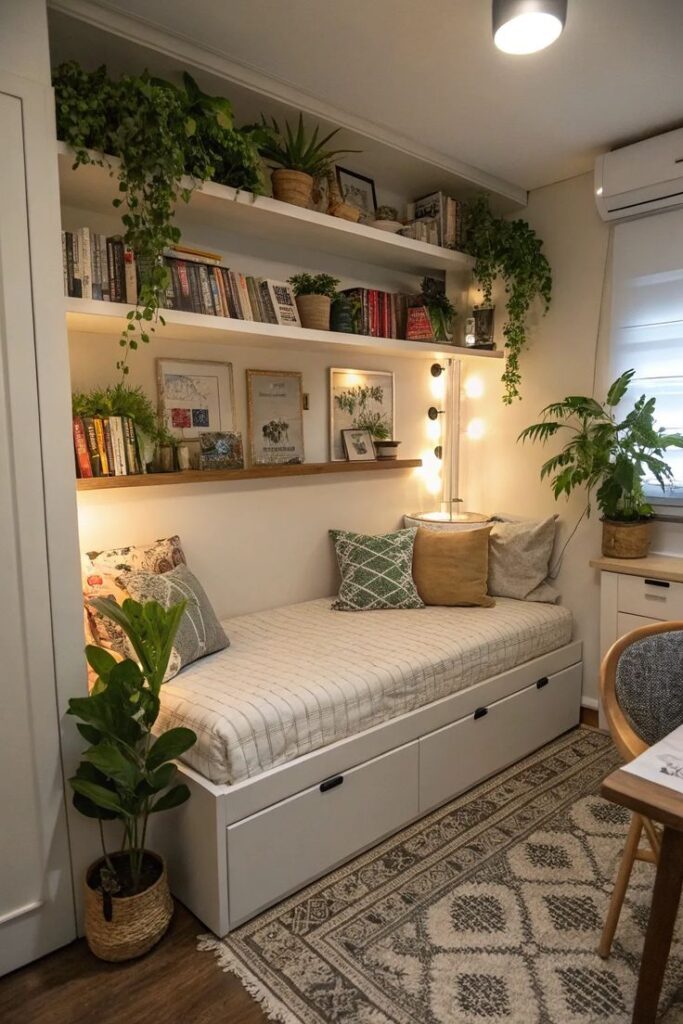
Theme It Up: Sparking Imagination
A theme can transform a plain room into an extraordinary adventure. It’s not about making everything match perfectly, but about creating an immersive experience that aligns with your child’s passions. From subtle nods to full-blown fantastical realms, themes add that magical “wow” factor.
Beyond the Obvious: Unique Theme Ideas
While princesses and superheroes are always popular, consider themes that allow for more creativity and longevity.
- Adventure Explorer: Think maps, globes, binoculars, vintage suitcases, and animal prints. This theme encourages curiosity about the world.
- Under the Sea: Blue and green hues, fish decals, seashell collections, and wave-like patterns. You can even find bedding that looks like a mermaid tail or a shark.
- Enchanted Forest: Forest murals, fairy lights, faux vines, mushroom stools, and woodland animal motifs. This creates a serene, magical atmosphere.
- Sports Fanatic: This is a classic. Showcase their favorite team’s colors, use sports equipment as decor (e.g., a basketball hoop over a laundry hamper, baseball bat curtain rods), and display trophies.
- Artist’s Studio: White or blackboard walls, easels, colorful art supplies, and areas to display their creations. This encourages a budding Picasso.
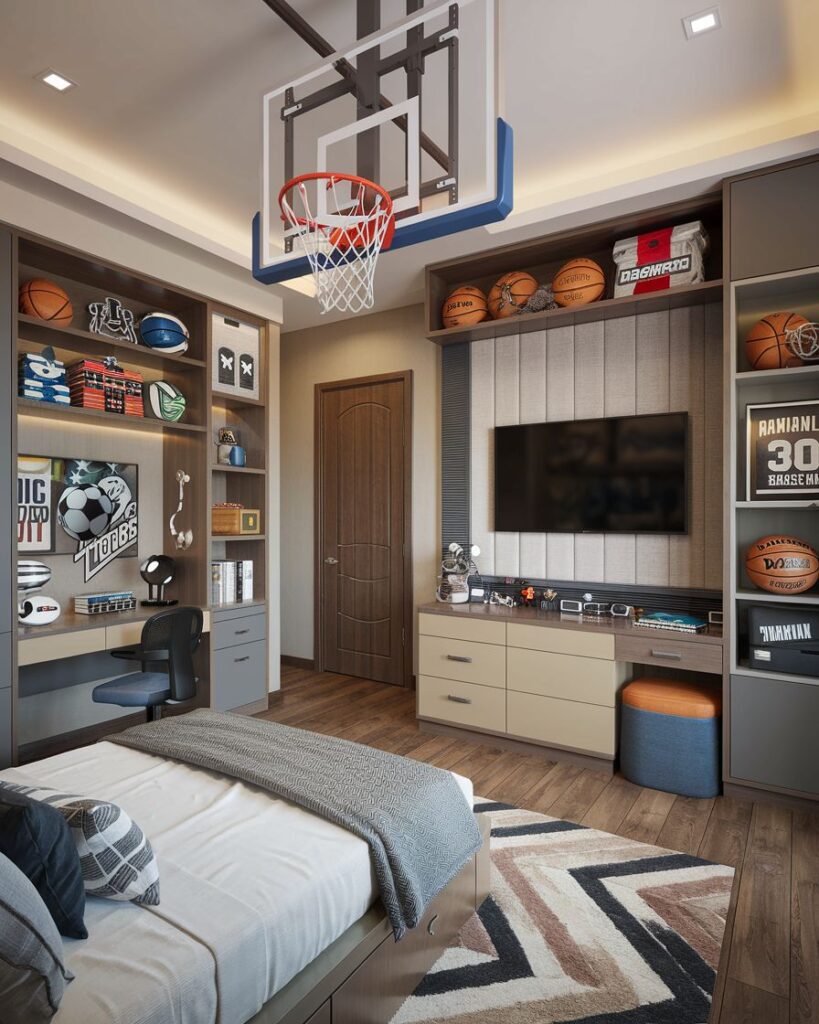
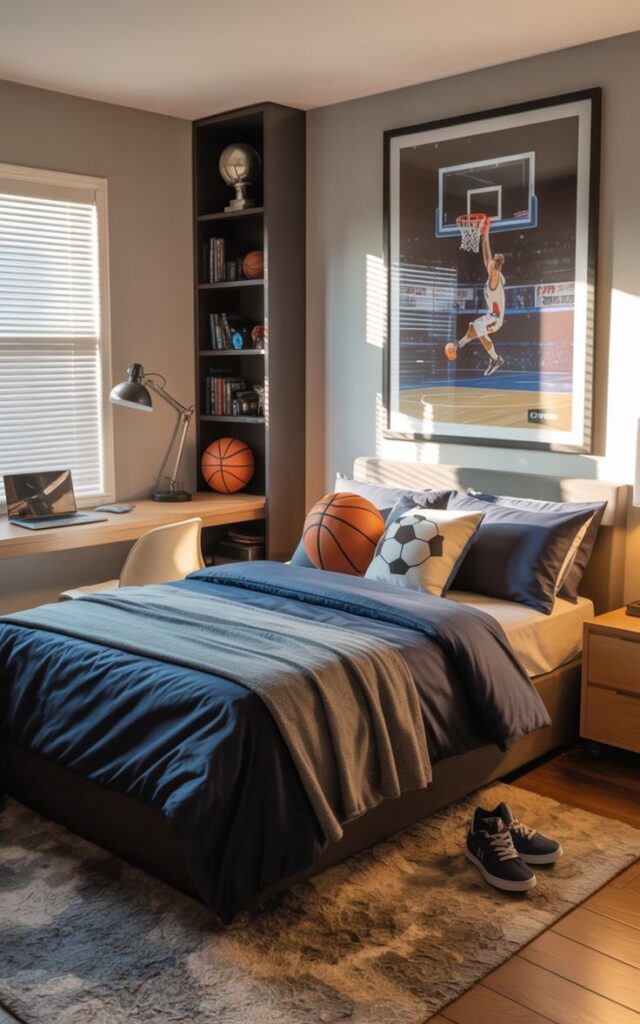
Making Themes Adaptable
The trick with themed rooms is to make them easy to change as your child’s interests evolve.
- Focus on Accessories: Instead of painting an entire wall with a complex mural, use themed bedding, curtains, rugs, and wall decals. These are much easier (and cheaper) to swap out later.
- Neutral Base: Keep the core elements like wall color and main furniture pieces relatively neutral. A light grey, a soft beige, or a calm blue can serve as a versatile backdrop for many themes.
- DIY Elements: Involve your child in creating themed decorations. This not only makes the room more personal but also gives them a sense of ownership.
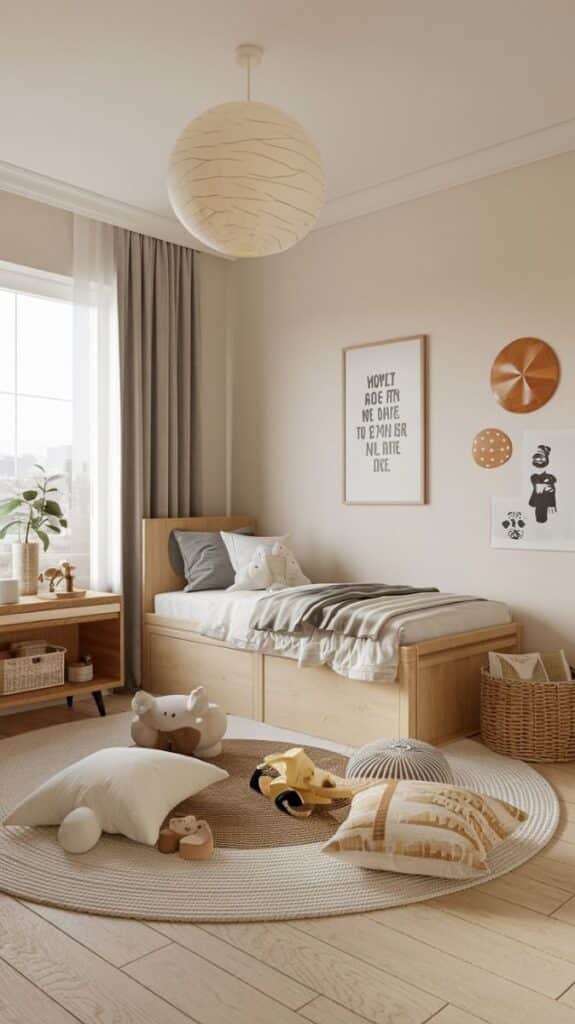

Color Power: Setting the Mood
Colors do more than just look pretty; they influence mood, energy levels, and even sleep quality. For a fun and casual kids’ room, you want a palette that feels inviting and stimulating without being overwhelming.
The Psychology of Kids’ Room Colors
- Blues & Greens: Calming and serene, perfect for promoting relaxation and sleep. Great for a primary base color.
- Yellows: Cheerful and optimistic, but too much can be overstimulating. Use as an accent.
- Oranges: Energetic and warm, encouraging social interaction and creativity. Best used in moderation.
- Pinks & Purples: Often associated with comfort and imagination. Lighter shades can be soothing, while brighter ones add a playful pop.
- Neutrals (Grays, Beiges, Whites): Provide a fantastic backdrop for colorful toys and accessories, allowing the child’s personality to shine through.
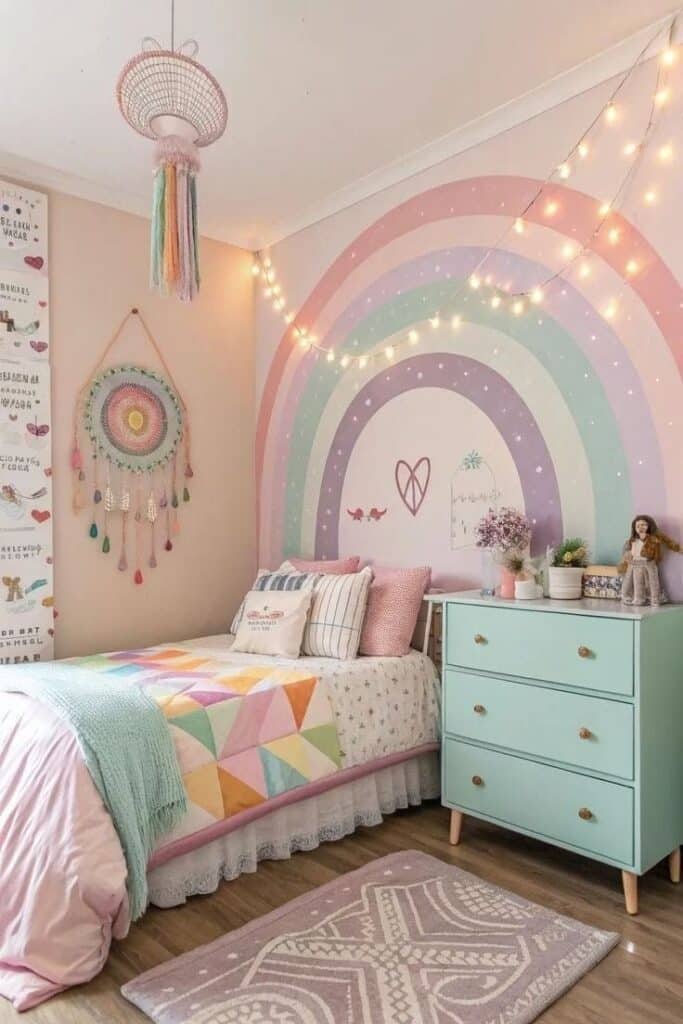
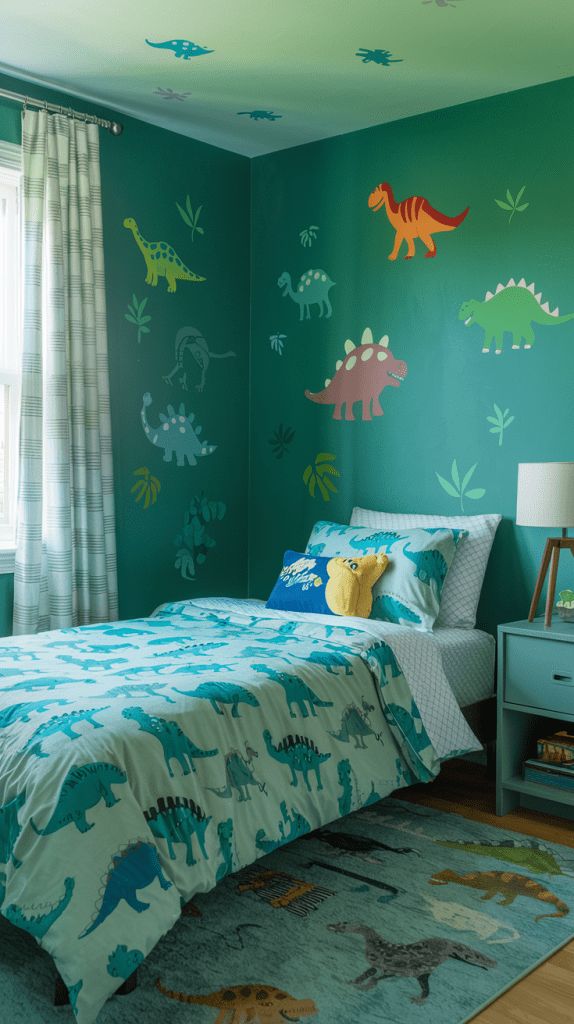
Mixing and Matching for Fun
Don’t be afraid to combine colors! A neutral wall paired with a brightly colored rug and vibrant accessories can create a dynamic yet balanced look.
- Accent Walls: Paint one wall a bold color or apply a fun wallpaper pattern to create a focal point without overwhelming the entire room.
- Color Blocking: Use two or three complementary colors in large blocks on the walls or through furniture pieces for a modern, playful feel.
- Rainbow Accents: If your child loves all colors, integrate a rainbow through bedding, art, or a collection of different colored storage bins against a neutral backdrop.
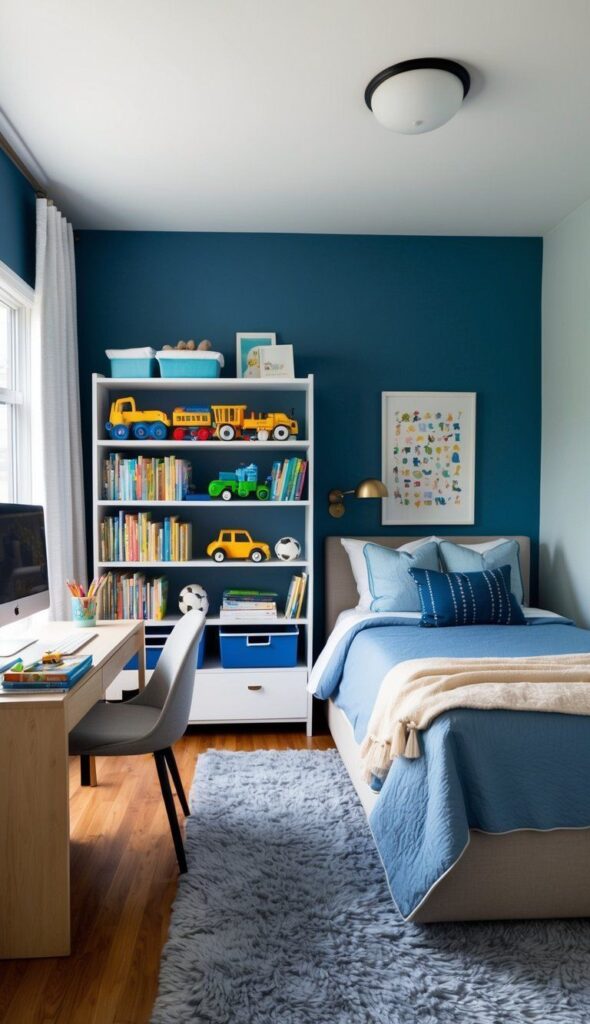
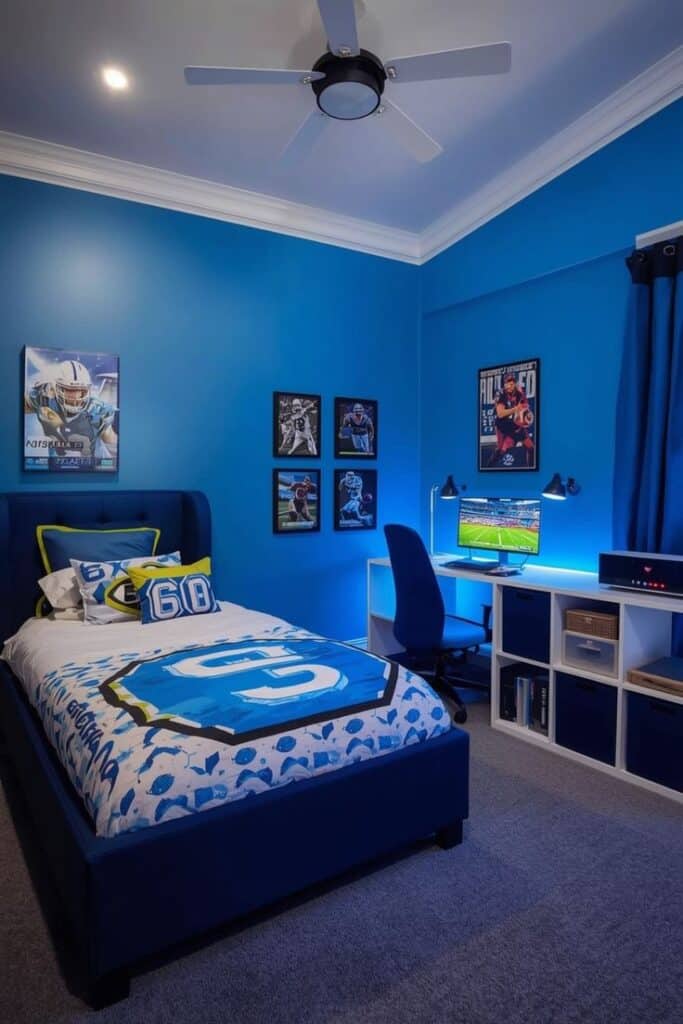
Smart Storage Solutions: Taming the Chaos
Let’s be honest: kids come with stuff. Lots of stuff. Toys, books, clothes, art supplies, school projects – it all needs a home. Effective storage is crucial for maintaining a fun, casual, and functional space that doesn’t feel perpetually messy. The goal isn’t to hide everything, but to create systems that make cleanup easier for both you and your child. This aligns perfectly with the goal of 10 tidy room tips to help keep things manageable.
Maximizing Every Inch
- Vertical Storage: Look up! Tall bookshelves, wall-mounted cubbies, and floating shelves maximize vertical space, especially in smaller rooms.
- Under-Bed Storage: Rolling bins or drawers under the bed are perfect for toys, extra bedding, or out-of-season clothes.
- Built-in Solutions: If your budget allows, built-in shelving, desks, or window seats with hidden storage can be game-changers for organization and aesthetic appeal. This is a smart approach for maximizing your space: 20 genius design ideas for small homes and apartments.
Kid-Friendly Organization
- Open Bins & Baskets: These make cleanup a breeze. Label them with pictures (for younger kids) or words so they know where everything belongs. Fabric bins add a touch of softness and come in various colors and patterns.
- Pegboards: A pegboard on the wall with hooks and small shelves is incredibly versatile. It can hold art supplies, dress-up clothes, small toys, or display cherished items.
- Toy Rotation: Instead of having all toys out at once, rotate them every few weeks. This keeps the room less cluttered and makes old toys feel new again.
- Clothing Organizers: A small dresser, a closet system with low-hanging rods, and labeled drawers can help teach children to put away their clothes independently.


Furniture That Grows: Investing Wisely
Kids grow fast, and so do their furniture needs. Choosing versatile pieces that can adapt to different stages of childhood is a smart move both financially and practically.
Multi-Functional Marvels
- Convertible Cribs: Many cribs convert into toddler beds, daybeds, and even full-sized beds, providing years of use.
- Adjustable Desks & Chairs: Look for desks with adjustable heights or chairs that can grow with your child to ensure ergonomic support for homework and creative projects.
- Daybeds or Trundle Beds: These are fantastic for sleepovers and offer extra seating during the day. A daybed can easily transition into a teen’s lounge spot.
- Modular Storage: Cube organizers can be stacked, reconfigured, and added to as storage needs change. They’re great for holding toys in fabric bins and later, books and display items.
Durability and Style
Kids’ furniture needs to withstand a lot of wear and tear. Choose sturdy, easy-to-clean materials. But durability doesn’t mean sacrificing style.
- Classic Wood Pieces: A well-made wooden dresser or bookshelf can last for decades and can be easily repainted or refinished to match new decor.
- Neutral Upholstery: If you choose upholstered furniture (like a small armchair or daybed), consider a neutral, durable fabric that can be dressed up with colorful pillows or throws.
- Consider the Future: When selecting larger, more expensive items, think about whether they will still be appropriate for a teenager or even an adult guest room. Simple, timeless designs often have the longest lifespan.
Lighting the Way: Practical and Playful Illumination
Good lighting in a child’s room needs to be functional for various activities – playing, reading, studying, and sleeping – while also adding to the room’s fun and casual atmosphere.
Layered Lighting Approach
- Ambient Lighting: This is the general overhead light, usually from a ceiling fixture. A flush-mount light or a fun pendant can be a great starting point.
- Task Lighting: Essential for reading and studying. A desk lamp with an adjustable arm or a bedside lamp provides focused light where needed.
- Accent Lighting: This is where the fun comes in! String lights, fairy lights, LED strip lights under a bed or shelf, or a whimsical nightlight can add warmth, character, and a touch of magic. Think about creating aesthetic spaces: design tips for your home by thoughtfully integrating various light sources.
Playful Light Fixtures
- Themed Lamps: A lamp shaped like a rocket, a unicorn, or a favorite cartoon character can reinforce the room’s theme.
- Glow-in-the-Dark Stars: A classic for a reason! They add a dreamy element to bedtime.
- Dimmers: Installing a dimmer switch for the main light allows you to adjust the brightness, creating a softer mood for bedtime stories or brighter light for playtime.
- Nightlights: A comforting glow can help ease nighttime fears and make navigating the room in the dark safer. Choose a fun, decorative one.
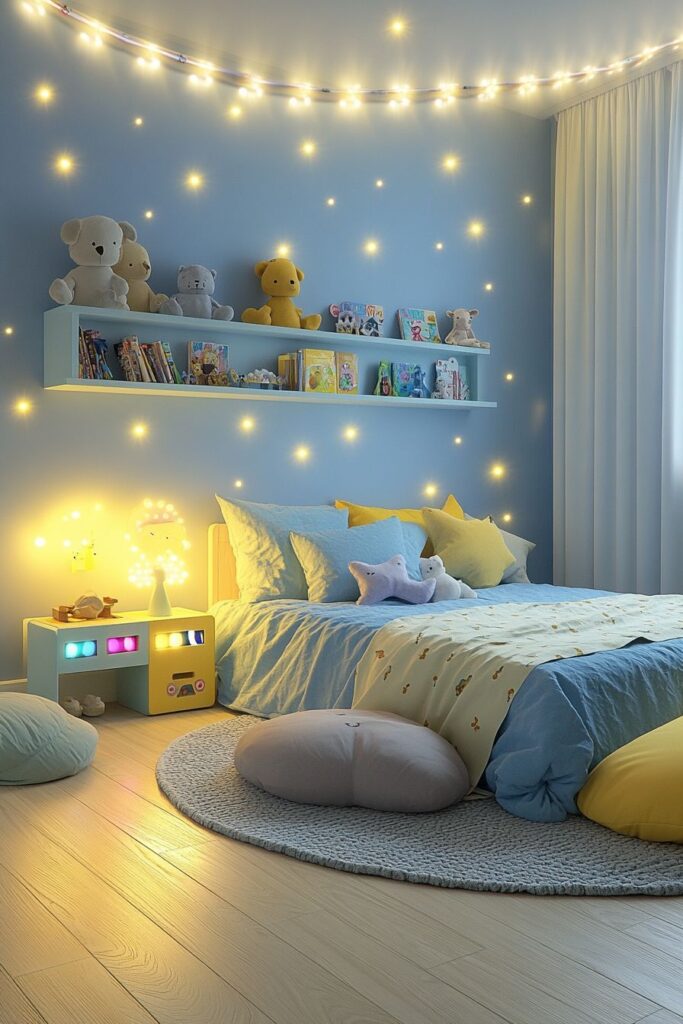
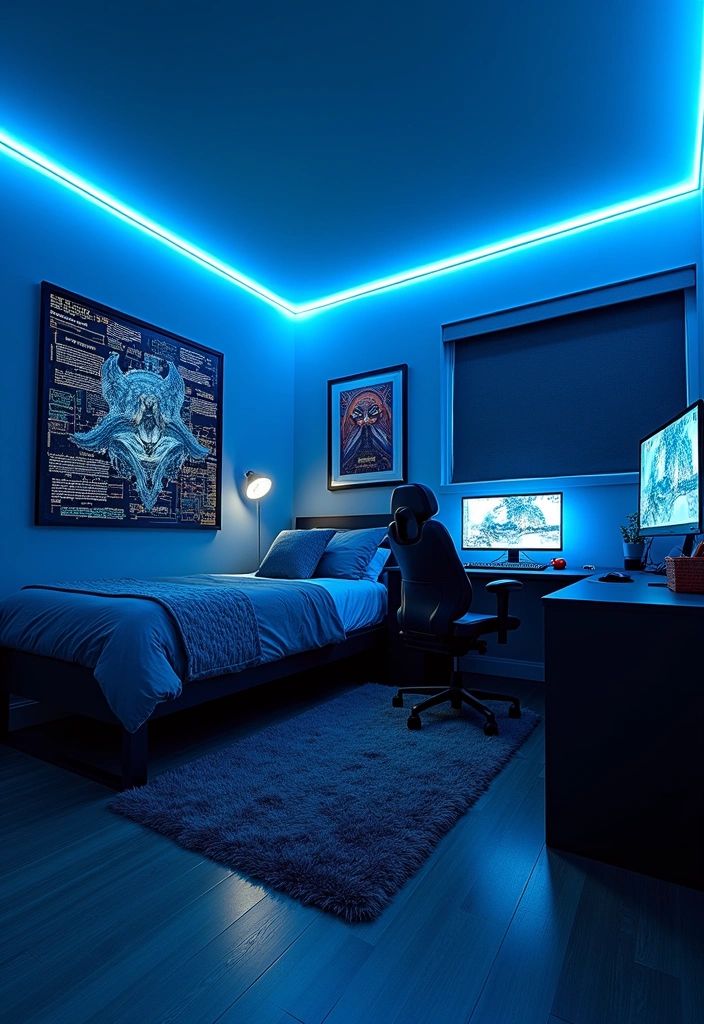
Flooring Fun: Durability Meets Design
The floor of a kid’s room takes a beating. It’s where most of the playing happens, where spills occur, and where toys are dropped. Therefore, durability, safety, and ease of cleaning are paramount, but that doesn’t mean sacrificing style.
Best Flooring Options
- Carpet: Offers softness, warmth, and sound absorption, which is great for lively play. Opt for low-pile, stain-resistant options in a durable fiber. Patterned carpets can help hide minor stains.
- Laminate Flooring: A durable and affordable option that mimics the look of wood. It’s scratch-resistant and relatively easy to clean.
- Vinyl Plank Flooring: Highly resilient, waterproof, and comes in a huge variety of styles, including wood and tile looks. It’s soft underfoot and quiet.
- Hardwood: While beautiful, hardwood can be prone to scratches from toys. If you go this route, choose a durable finish and protect it with rugs.
Rugs: The Ultimate Play Zone & Style Statement
Even with carpet, a large area rug can define a play zone, add warmth, and inject personality. For hard floors, a rug is essential for comfort and safety. As the foundation of the room, a rug truly sets the tone, much like how your rug sets the tone for your entire room.
- Patterned Rugs: Stripes, polka dots, geometric shapes, or even road maps can be incredibly fun and stimulate imaginative play.
- Washable Rugs: A game-changer! Many brands now offer machine-washable rugs, which are a godsend for kids’ rooms.
- Soft & Plush: A thick, soft rug provides a comfortable surface for crawling, sitting, and tumbling.
- Non-Slip Backing: Always use a rug pad or choose a rug with a non-slip backing to prevent accidents.


Wall Wonders: Beyond Paint
Walls are a blank canvas, offering endless possibilities for creative expression in a kid’s room. Beyond a simple coat of paint, there are many ways to add texture, pattern, and personality.
Creative Wall Treatments
- Wallpaper: Modern wallpapers come in countless kid-friendly designs – from whimsical animals and vibrant florals to subtle patterns and geometric prints. Peel-and-stick options are great for renters or those who like to change things up easily.
- Wall Decals: A versatile and temporary option for themes. They come in every shape and size imaginable and can be easily removed without damaging paint.
- Murals: A hand-painted mural can be a stunning focal point, but consider hiring a professional or using large wall decals for a similar effect that’s easier to change.
- Chalkboard or Whiteboard Walls: Paint one section of a wall with chalkboard or whiteboard paint. This provides an instant creative outlet for drawing, practicing letters, or leaving messages.
- Gallery Walls: Mix framed artwork (your child’s masterpieces!), photos, shelves with small treasures, and mirrors to create a dynamic display.
Incorporating Art & Displays
- Child’s Artwork: Frame their drawings and paintings. This is the most personal and heartwarming wall decor you can have.
- Fabric Hangings: Colorful tapestries, banners, or even a quilt can add softness, color, and visual interest.
- Shelves for Display: Floating shelves are perfect for showcasing small toys, books, and decorative items. Keep them securely mounted and within reach for older children, but higher up for toddlers.
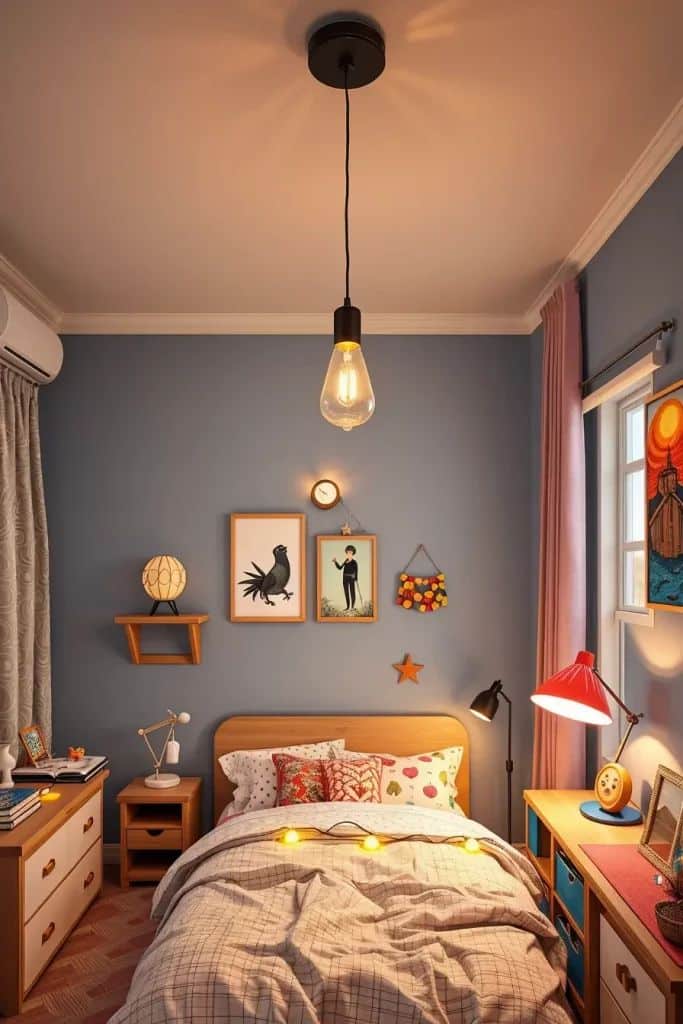
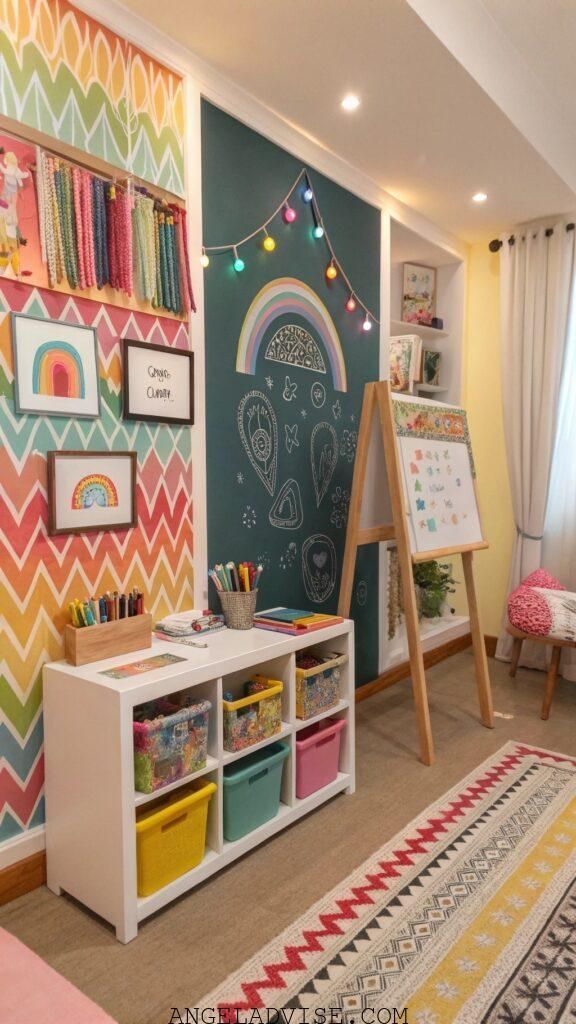
Personal Touches: Making It Truly Their Own
This is where the room truly becomes theirs. Allowing your child to have input in the design process, even in small ways, fosters a sense of ownership and pride. A casual room is one that reflects the unique personality of its occupant.
Involving Your Child in Design
- Color Choices: Offer them a few pre-approved color swatches and let them pick their favorite.
- Theme Input: Ask what they love! Dinosaurs? Stars? Animals? This conversation sparks excitement.
- Accessory Selection: Let them choose their own bedding, a fun lamp, or a piece of wall art.
- DIY Projects: Engage them in creating some of the decor. This could be painting a canvas, decorating storage bins, or even helping you apply wall decals.
Showcasing Their Personality
- Display Their Collections: Whether it’s action figures, dolls, rocks, or Lego creations, dedicated display shelves or shadow boxes let them show off their passions.
- Photos: Include framed photos of family, friends, or pets.
- Trophies and Ribbons: A designated shelf or pegboard for achievements reinforces their efforts and passions.
- Name Decor: A personalized name sign or initial on the wall adds a special touch.
Safety First, Always: Essential Considerations
While fun and casual are the goals, safety should always be the top priority in a child’s bedroom design. This means thinking about everything from furniture stability to window treatments.
Key Safety Checks
- Furniture Anchoring: All tall furniture – dressers, bookshelves, wardrobes – must be anchored to the wall to prevent tipping. This is non-negotiable and saves lives.
- Window Safety: Use cordless blinds or curtains to eliminate the risk of strangulation from cords. Consider window guards for higher windows.
- Electrical Outlets: Cover all unused electrical outlets with child-proof covers.
- Cords and Wires: Keep lamp cords and other electrical wires tucked away and out of reach to prevent tripping hazards or accidental pulling.
- Non-Toxic Materials: Choose paints, finishes, and furniture made from non-toxic, child-safe materials, especially for infants and toddlers who might put things in their mouths.
- Sharp Edges: Opt for furniture with rounded edges. If existing furniture has sharp corners, add corner guards.
- Rug Placement: Ensure all rugs have non-slip backings to prevent falls.
- Air Quality: Ensure good ventilation. Consider an air purifier if allergies are a concern. Regular cleaning is also key.
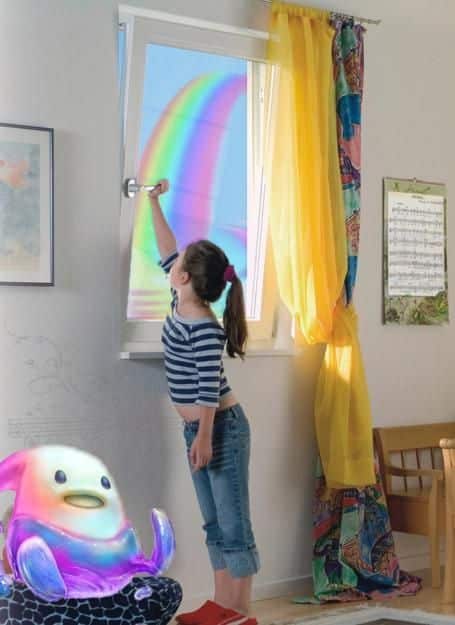
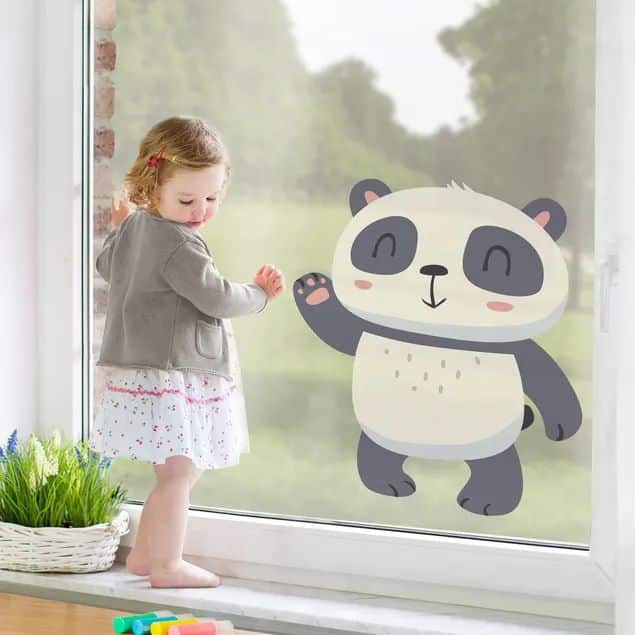
DIY Magic: Adding Unique Flair
DIY projects are a fantastic way to infuse a kid’s room with personality, save money, and create truly unique pieces. They also offer a great opportunity to involve your child in the design process.
Simple Yet Impactful DIY Ideas
- Painted Furniture: Give an old dresser or bookshelf a new lease on life with a fresh coat of paint in a fun, bright color or a playful pattern. Stencils can add intricate designs without being an expert artist.
- Custom Headboard: Create a simple upholstered headboard with foam and fabric, or use plywood cut into a fun shape (like a cloud or a mountain) and paint it.
- Gallery Wall of Art: Frame your child’s artwork in simple, inexpensive frames. You can even spray paint the frames to match the room’s color scheme.
- Repurposed Storage: Decorate plain storage bins or baskets with paint, fabric scraps, or even their own drawings. Old crates can be stacked and secured for unique shelving.
- Fairy Light Canopy: Drape fairy lights over a sheer canopy above the bed for a magical, dreamy effect.
- Pom-Pom Garland: Easily made from yarn, these colorful garlands add a whimsical touch to walls, windows, or bed frames.
Bringing Nature In: A Breath of Fresh Air
Connecting children with nature, even indoors, can have a calming and inspiring effect. Incorporating natural elements into a bedroom design can create a serene, grounded atmosphere that complements the fun and casual vibe.
Natural Elements and Motifs
- Plants: Introduce child-safe, non-toxic plants (e.g., spider plants, Boston ferns, succulents) in cute pots. They help purify the air and add a touch of living green.
- Wood Accents: Natural wood furniture or decor items bring warmth and texture. Think a wooden desk, shelves, or even a branch used as a decorative element.
- Nature-Inspired Art: Framed prints of animals, trees, mountains, or oceans can bring the outdoors in.
- Natural Materials: Choose bedding or rugs made from cotton, linen, or wool for a soft, earthy feel.
- Terrariums or Aquariums: If space and maintenance allow, a small, well-maintained terrarium or a fish tank can be a fascinating addition, teaching responsibility and observation. You could even try a DIY jar terrarium project with your child!
The End Goal: A Happy Child
Ultimately, the best kid’s bedroom is one where your child feels safe, happy, and inspired. It’s a space that supports their growth, encourages their imagination, and offers comfort at the end of a busy day. By focusing on personalization, smart storage, adaptable design, and, most importantly, involving your child in the process, you can create a fun, casual haven that they’ll cherish for years to come. Remember, perfection isn’t the goal; a lived-in, loved, and laughter-filled room is. So, roll up your sleeves, embrace the mess that comes with creativity, and have fun building a dream room for your little one!
- 141shares
- Facebook0
- Pinterest141
- Twitter0

